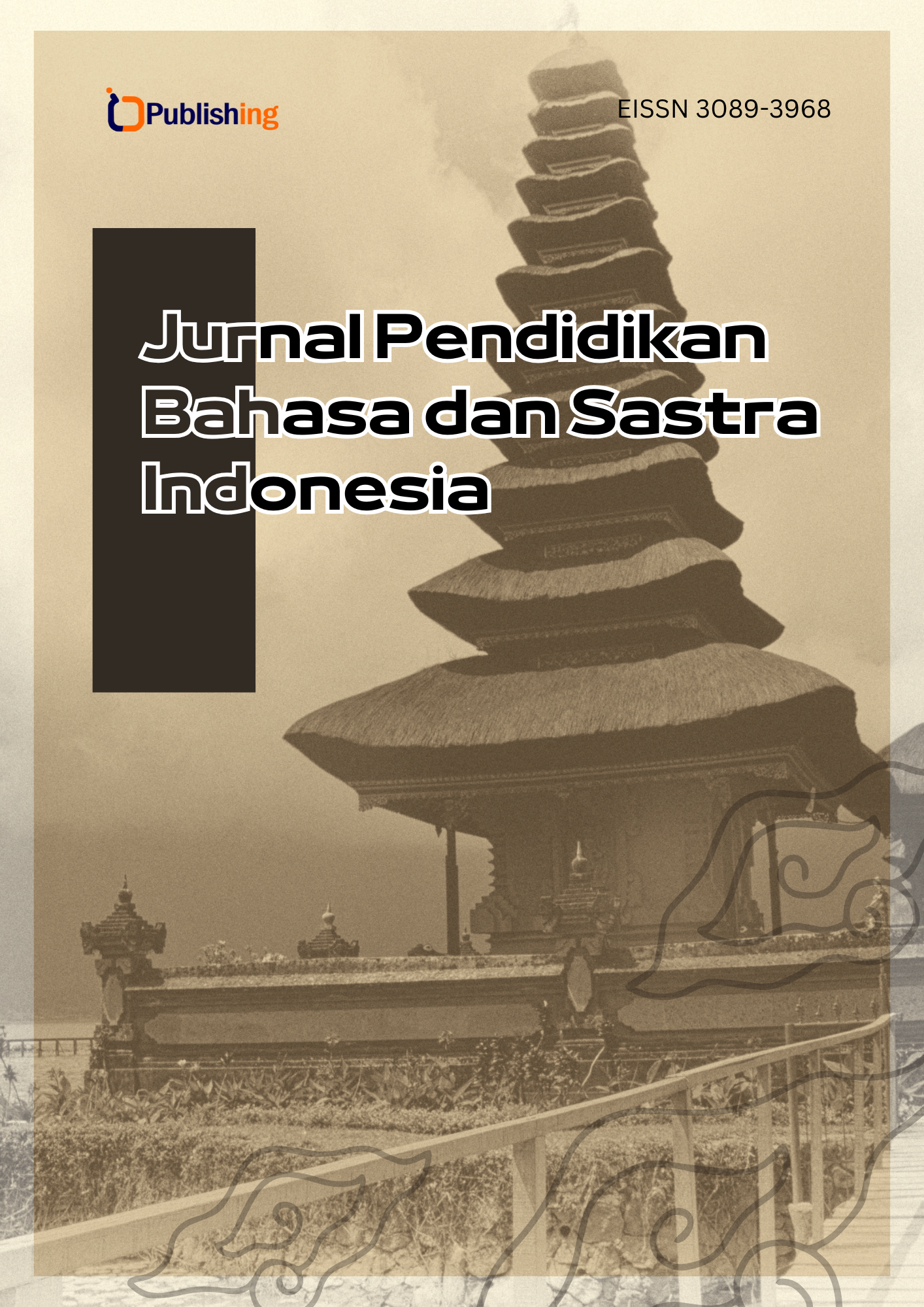Pengaruh Program Gerakan Literasi Sekolah terhadap Minat Baca Siswa Kelas 9 di SMPN 2 Waru
DOI:
https://doi.org/10.47134/jpbsi.v1i1.1190Keywords:
Gerakan Literasi Sekolah, Minat Baca, Pendidikan Literasi, Budaya MembacaAbstract
Rendahnya minat baca di kalangan siswa merupakan salah satu masalah serius di Indonesia. Penelitian ini bertujuan untuk mengeksplorasi dampak Program Gerakan Literasi Sekolah (GLS) terhadap minat baca siswa kelas 9 di SMPN 2 Waru. Dengan menggunakan pendekatan kuantitatif, sampel sebanyak 70 siswa yang berpartisipasi dalam program GLS dipilih menggunakan metode Slovin. Pengumpulan data dilakukan melalui kuesioner berbasis skala Likert, dan analisis mencakup uji validitas, reliabilitas, serta normalitas sebagai pra uji. Setelah itu, dilakukan uji t untuk menguji hipotesis dan menentukan apakah ada pengaruh yang signifikan antara pelaksanaan program GLS terhadap minat baca siswa. Hasil penelitian menunjukkan bahwa pelaksanaan program GLS secara signifikan meningkatkan minat dan frekuensi membaca siswa. Faktor-faktor seperti jadwal membaca yang teratur, fasilitas perpustakaan yang lengkap, dan peran aktif guru menjadi faktor utama keberhasilan program ini. Penelitian ini menegaskan bahwa dengan dukungan yang memadai, program literasi dapat berhasil meningkatkan minat baca siswa serta memperkuat budaya literasi di lingkungan sekolah
References
Elendiana, M. (2020). Upaya Meningkatkan Minat Baca Siswa Sekolah Dasar. Jurnal Pendidikan Dan Konseling (JPDK), 2(1), 54–60. DOI: https://doi.org/10.31004/jpdk.v1i2.572
Ernitawati, Y., Izzati, N., & Yulianto, A. (2020). Pengaruh Literasi Keuangan Dan Pelatihan Pasar Modal Terhadap Pengambilan Keputusan Investasi. Jurnal Proaksi, 7(2), 66–81. https://doi.org/10.32534/jpk.v7i2.1273 DOI: https://doi.org/10.32534/jpk.v7i2.1273
Faradina, N. (2017). Pengaruh program gerakan literasi sekolah terhadap minat baca siswa di SD Islam Terpadu Muhammadiyah An-Najah Jatinom Klaten. Hanata Widya, 6(8), 60- 69.
Hartayani, M. S., & Sandiasa, G. (2022). Peranan Teknologi Informasi Dalam Meningkatkan Efektivitas Pelayanan Tata Usaha Pada Smk Negeri 1 Sukasada. Peranan Teknologi Informasi Dalam Meningkatkan Efektivitas Pelayanan Tata Usaha Pada Smk Negeri 1 Sukasada, 14(2), 39–54. https://doi.org/10.37637/locus.v14i2.1020 DOI: https://doi.org/10.37637/locus.v14i2.1020
Herlina, Erisna, & Fitria, H. (2020). Prosiding seminar nasional pendidikan program pascasarjana universitas pgri palembang 10 januari 2020. Prosiding Seminar Nasional Pendidikan Program Pascasarjana Universitas Pgri Palembang, 2, 599.
Husen, A. (2023). Strategi Pemasaran Melalui Digital Marketing Campaign Di Toko Mebel Sakinah Karawang. Jurnal Economina, 2(6), 1356–1362. https://doi.org/10.55681/economina.v2i6.608 DOI: https://doi.org/10.55681/economina.v2i6.608
Mauliddiyah, N. L. (2021). Pengaruh Gerakan Literasi Sekolah Terhadap Minat Baca Siswa Kelas Va Sd Negeri 146 Pekanbaru. Pengaruh Gerakan Literasi Sekolah Terhadap Minat Baca Siswa Kelas Va Sd Negeri 146 Pekanbaru, 6. DOI: https://doi.org/10.31004/basicedu.v6i4.3207
Nopita, H. (2021). Pengaruh Program Gerakan Literasi Sekolah Terhadap Minat baca Siswa di SDIT Insan Utama 2 Pekanbaru (Doctoral dissertation, Universitas Islam Riau). DOI: https://doi.org/10.46244/tunasbangsa.v8i2.1644
Nova, M., Aminuyati, & Okiyana. (2015). Pengaruh Minat Membaca di Perpustakaan terhadap Hasil Belajar. Jurnal UNTAN, 5.
Bailey, C. (2023). ‘Neurodivergent literacies’: exploring autistic adults’ ‘ruling passions’ and embracing neurodiversity through classroom literacies. Literacy, 57(2), 120–131. https://doi.org/10.1111/lit.12320 DOI: https://doi.org/10.1111/lit.12320
Boerman-Cornell, W. (2017). Using Harry Potter to Bridge Higher Dimensionality in Mathematics and High-Interest Literature. Journal of Adolescent and Adult Literacy, 60(4), 425–432. https://doi.org/10.1002/jaal.597 DOI: https://doi.org/10.1002/jaal.597
Feng, J. (2019). The theoretical study on babies and toddlers’ reading programs in the United States. Journal of Library Science in China, 45(6), 119–129. https://doi.org/10.13530/j.cnki.jlis.190054
Hedemark, Å. (2020). Constructing the literate child: an analysis of Swedish literature policy. Library and Information History, 36(2), 73–88. https://doi.org/10.3366/lih.2020.0018 DOI: https://doi.org/10.3366/lih.2020.0018
Jatmika, S. (2020). The School Literacy Movement and Its Implementation in Vocational High Schools in Indonesia. International Journal of Literacies, 27(1), 19–30. https://doi.org/10.18848/2327-0136/CGP/v27i01/19-30. DOI: https://doi.org/10.18848/2327-0136/CGP/v27i01/19-30
Medrano, L. M. S. M. (2022). The Otomí autonomous educational project: supporting children’s literacy and agency. Journal for Critical Education Policy Studies, 20(1), 174–198.
NeCamp, S. (2014). Adult literacy and American identity: The Moonlight schools and Americanization programs. Adult Literacy and American Identity: The Moonlight Schools and Americanization Programs, 1–187.
Nelson, P. (2018). An examination of student reading outcomes following tier II exit decisions. Journal of School Psychology, 68, 142–153. https://doi.org/10.1016/j.jsp.2018.03.003 DOI: https://doi.org/10.1016/j.jsp.2018.03.003
Nuryana, Z. (2020). Literation movement for leading schools: Best practice and leadership power. International Journal of Evaluation and Research in Education, 9(1), 227–233. https://doi.org/10.11591/ijere.v9i1.20279 DOI: https://doi.org/10.11591/ijere.v9i1.20279
Ramírez, H. C. (2023). The Bible in Latin America and the Caribbean before Vatican Council II. Theologica Xaveriana, 73, 1–24. https://doi.org/10.11144/javeriana.tx73.balccv DOI: https://doi.org/10.11144/javeriana.tx73.balccv
Rintaningrum, R. (2019). Explaining the important contribution of reading literacy to the country’s generations: Indonesian’s perspectives. International Journal of Innovation, Creativity and Change, 5(3), 936–953.
Shinta, V. R. (2023). Literacy Class: Instructional Design at High School. Record and Library Journal, 9(1), 56–65. https://doi.org/10.20473/rlj.V9-I1.2023.56-65 DOI: https://doi.org/10.20473/rlj.V9-I1.2023.56-65
Siregar, M. R. B. (2022). Peran Literasi Baca Tulis Dalam Menumbuhkan Minat Membaca Siswa di Madrasah Tsnawiyah Negeri. Munaddhomah, 3(2), 149–159. https://doi.org/10.31538/munaddhomah.v3i2.237 DOI: https://doi.org/10.31538/munaddhomah.v3i2.237
Ward, N. (2022). Early Reading Instruction: Politics and Myths About Materials and Methods. How Education Policy Shapes Literacy Instruction: Understanding the Persistent Problems of Policy and Practice, 89–119. https://doi.org/10.1007/978-3-031-08510-9_4 DOI: https://doi.org/10.1007/978-3-031-08510-9_4
Downloads
Published
How to Cite
Issue
Section
License
Copyright (c) 2024 Sa'diyatul Munawwaroh, Azmi Mujahidah, Elvaritta Faunia Dewi, Reva Oktavia Sari, Azlina Laila Syahriza, Ayu Wulandari

This work is licensed under a Creative Commons Attribution 4.0 International License.





